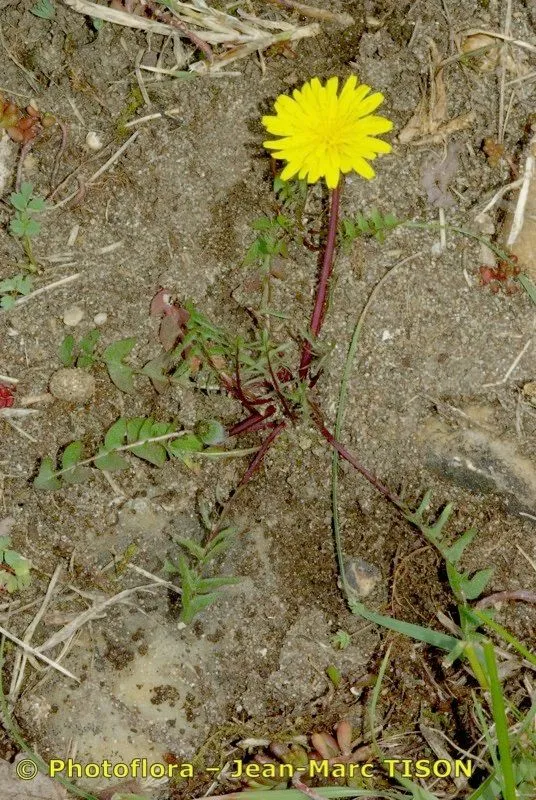
Author: Dahlst.
Bibliography: Bot. Not. 1905: 166 (1905)
Year: 1905
Status: accepted
Rank: species
Genus: Taraxacum
Vegetable: False
Observations: Europe
The Ruddy Dandelion, scientifically known as Taraxacum rubicundum, is a fascinating member of the Asteraceae family. Its unique characteristics contribute significantly to the botanical diversity within its native range across Europe.
First described by Dahlst. in the early 20th century, specifically in “Botaniska Notiser” of 1905, the Ruddy Dandelion stands out for its vibrant appearance and resilient nature. The plant’s morphology resembles that of the common dandelion but with subtle differences that distinguish it as a separate species. Particularly notable are the rich, reddish hues of its flower heads, which add a touch of color to the meadows and fields it inhabits.
The Ruddy Dandelion exhibits typical dandelion-like features, including deeply lobed leaves that form a basal rosette. These leaves lay flat on the ground, an evolutionary trait that allows the plant to maximize its absorption of sunlight while minimizing competition for space with neighboring flora. The inflorescence emerges from a hollow stalk, culminating in a cluster of delicate, ray-like florets. These florets are primarily responsible for the plant’s bright and attractive reddish tinge, providing a stark contrast to the more ubiquitous yellow dandelions.
Ecologically, Taraxacum rubicundum plays a crucial role in its environment. It serves as a vital source of nectar for various pollinators, including bees and butterflies, thus supporting the broader ecosystem. In addition to its ecological benefits, the plant is also recognized for its adaptability to different soil types and conditions. This adaptability ensures that the Ruddy Dandelion can thrive in a variety of habitats, from lush meadows to more arid locales.
Despite its resilience, the Ruddy Dandelion faces challenges from habitat loss and competition with invasive species. Conservation efforts are essential to ensure the continued presence of this beautiful plant in its native regions. Gardeners and botanists can assist in its preservation by cultivating Taraxacum rubicundum in suitable environments and promoting awareness of its ecological importance.
In conclusion, the Ruddy Dandelion (Taraxacum rubicundum) is a captivating plant with a significant ecological role within European landscapes. Its distinctive red-tinged flowers not only add aesthetic value but also support a range of pollinators, reflecting the interconnectedness of our natural world. Understanding and appreciating such species underscores the importance of biodiversity and our responsibility to protect it.
Deu: geröteter löwenzahn
Fra: pissenlit, pissenlit rubicond
Dan: rubin-sandmælkebøtte
Eng: ruddy dandelion
Nob: rubinløvetann
Nno: rubinløvetann
Swe: rubinmaskros
En: Ruddy Dandelion
Da: Rubin-sandmælkebøtte
Fi: Rubiinivoikukka
Fr: Pissenlit, Pissenlit rubicond
De: Geröteter Löwenzahn
Nb: Rubinløvetann
Nn: Rubinløvetann
Sv: Rubinmaskros
: Ruddy dandelion
© copyright of the Board of Trustees of the Royal Botanic Gardens, Kew.
Taken Dec 3, 2022 by Ignacio Buioli (cc-by-sa)
Taken Dec 20, 2021 by Iglesias Rafael (cc-by-sa)
Taken Nov 27, 2021 by Annemarie Ahrens-Stehle (cc-by-sa)
Taken Apr 13, 2008 by Andrzej Konstantynowicz (cc-by-sa)
Taken Apr 13, 2008 by Andrzej Konstantynowicz (cc-by-sa)
Taken Apr 29, 2014 by Andrzej Konstantynowicz (cc-by-sa)
Taken Apr 29, 2014 by Andrzej Konstantynowicz (cc-by-sa)
Taken Apr 10, 2020 by Annemarie Ahrens-Stehle (cc-by-sa)
Taken May 11, 2017 by Annemarie Ahrens-Stehle (cc-by-sa)
Taken Apr 29, 2014 by Andrzej Konstantynowicz (cc-by-sa)
Taken May 14, 2022 by Alain Lagrave (cc-by-sa)
Taken May 19, 2020 by Phil Black (cc-by-sa)
Taken Mar 26, 2022 by hieracium eriophorum (cc-by-sa)
Taken Mar 7, 2019 by Muriel Rivière Brucker (cc-by-sa)
Taken May 23, 2022 by Agnes Pfraumer (cc-by-sa)
Taken Mar 7, 2019 by Muriel Rivière Brucker (cc-by-sa)
Taken Apr 15, 2008 by Photoflora – Jean-Marc TISON (©)
Taken Mar 13, 2014 by Tela Botanica − Liliane Roubaudi (cc-by-sa)
Taken Mar 13, 2014 by Tela Botanica − Liliane Roubaudi (cc-by-sa)
Taken Mar 13, 2014 by Tela Botanica − Liliane Roubaudi (cc-by-sa)
Taken Apr 15, 2008 by Photoflora – Jean-Marc TISON (©)
Taken Apr 15, 2008 by Photoflora – Jean-Marc TISON (©)
Taken Mar 13, 2014 by Tela Botanica − Liliane Roubaudi (cc-by-sa)
Taken Mar 13, 2014 by Tela Botanica − Liliane Roubaudi (cc-by-sa)
Taken Mar 13, 2014 by Tela Botanica − Liliane Roubaudi (cc-by-sa)
Family: Myrtaceae Author: (F.Muell.) K.D.Hill & L.A.S.Johnson Bibliography: Telopea 6: 402 (1995) Year: 1995 Status:…
Family: Rubiaceae Author: Pierre ex A.Froehner Bibliography: Notizbl. Bot. Gart. Berlin-Dahlem 1: 237 (1897) Year:…
Family: Sapindaceae Author: Koidz. Bibliography: J. Coll. Sci. Imp. Univ. Tokyo 32(1): 38 (1911) Year:…
Family: Asteraceae Author: A.Gray Bibliography: Pacif. Railr. Rep.: 107 (1857) Year: 1857 Status: accepted Rank:…
Family: Fabaceae Author: Medik. Bibliography: Vorles. Churpfälz. Phys.-Ökon. Ges. 2: 398 (1787) Year: 1787 Status:…
Family: Aspleniaceae Author: (Cav.) Alston Bibliography: Bull. Misc. Inform. Kew 1932: 309 (1932) Year: 1932…